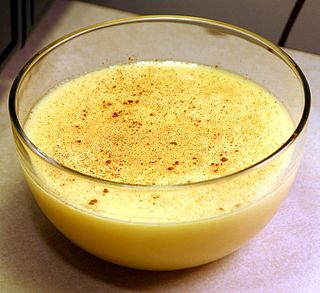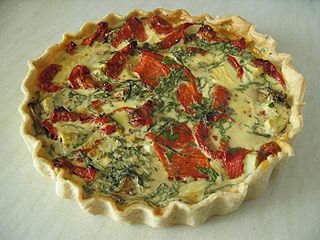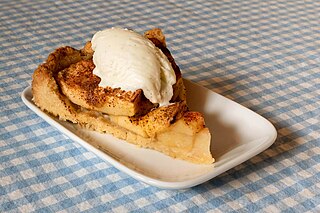
Custard is a variety of culinary preparations based on sweetened milk, cheese, or cream cooked with egg or egg yolk to thicken it, and sometimes also flour, corn starch, or gelatin. Depending on the recipe, custard may vary in consistency from a thin pouring sauce to the thick pastry cream used to fill éclairs. The most common custards are used in custard desserts or dessert sauces and typically include sugar and vanilla; however, savory custards are also found, e.g., in quiche.

Pastry refers to a variety of doughs, as well as the sweet and savoury baked goods made from them. These goods are often called pastries as a synecdoche, and the dough may be accordingly called pastry dough for clarity. Sweetened pastries are often described as bakers' confectionery. Common pastry dishes include pies, tarts, quiches, croissants, and pasties.

A pie is a baked dish which is usually made of a pastry dough casing that contains a filling of various sweet or savoury ingredients. Sweet pies may be filled with fruit, nuts, fruit preserves, brown sugar, sweetened vegetables, or with thicker fillings based on eggs and dairy. Savoury pies may be filled with meat, eggs and cheese or a mixture of meat and vegetables.

Quiche is a French tart consisting of a pastry crust filled with savoury custard and pieces of cheese, meat, seafood or vegetables. A well-known variant is quiche lorraine, which includes lardons or bacon. Quiche may be served hot, warm or cold.

Cheesecake is a dessert made with a soft fresh cheese, eggs, and sugar. It may have a crust or base made from crushed cookies, graham crackers, pastry, or sometimes sponge cake. Cheesecake may be baked or unbaked, and is usually refrigerated.

A tart is a baked dish consisting of a filling over a pastry base with an open top not covered with pastry. The pastry is usually shortcrust pastry; the filling may be sweet or savoury, though modern tarts are usually fruit-based, sometimes with custard. Tartlet refers to a miniature tart; an example would be egg tarts. The categories of "tart", "flan", and "pie" overlap, with no sharp distinctions.

Apple cakes are cakes in which apples feature as a main flavour and ingredient. Such cakes incorporate apples in a variety of forms, including diced, pureed, or stewed, and can include common additions like raisins, nuts, and 'sweet' spices such as cinnamon or nutmeg. They are a common and popular dessert worldwide, thanks to millennia of apple cultivation in Asia and Europe, and their widespread introduction and propagation throughout the Americas during the Columbian Exchange and colonisation. As a result, apple desserts, including cakes, have a huge number of variations.

Kuchen, the German word for cake, is used in other languages as the name for several different types of savory or sweet desserts, pastries, and gateaux. Most Kuchen have eggs, flour and sugar as common ingredients while also, but not always, including some fat. In the Germanosphere it is a common tradition to invite friends over to one's house or to a cafe between noon and evening to drink coffee and eat Kuchen.

Galette is a term used in French cuisine to designate various types of flat round or freeform crusty cakes, or, in the case of a Breton galette, a pancake made with buckwheat flour usually with a savoury filling. Of the cake type of galette, one notable variety is the galette des Rois eaten on the day of Epiphany. In French Canada the term galette is usually applied to pastries best described as large cookies.

Torta is a culinary term that can, depending on the cuisine, refer to cakes, pies, flatbreads, sandwiches, or omelettes.

Bougatsa is a Greek breakfast food, or mid-morning snack, or midday snack. Bougatsa has several versions with their own filling, with the most popular the bougatsa krema that has semolina custard filling used as a sweet food and dessert.

Kue is an Indonesian bite-sized snack or dessert food. Kue is a fairly broad term in Indonesian to describe a wide variety of snacks including cakes, cookies, fritters, pies, scones, and patisserie. Kue are made from a variety of ingredients in various forms; some are steamed, fried or baked. They are popular snacks in Indonesia, which has the largest variety of kue. Because of the countries' historical colonial ties, Koeé (kue) is also popular in the Netherlands.

Custard tarts or flan pâtissier/parisien are a baked pastry consisting of an outer pastry crust filled with egg custard.
The fourth season of The Great Canadian Baking Show premiered on CBC Television on February 14, 2021. As with previous seasons, ten amateur bakers will compete over eight weeks of challenges, vying for the title. The season marked the debut of Ann Pornel and Alan Shane Lewis as hosts, who replaced Carolyn Taylor and Aurora Browne. Bruno Feldeisen and Kyla Kennaley returned for their fourth and second seasons respectively as judges.















